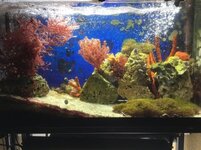Natural diet and grazing rate of the temperate sponge Dysidea avara(Demospongiae, Dendroceratida) throughout an annual cycle
Marta Ribes*, Rafel Coma, Josep-Maria Gili
Institut de Ciències del Mar (CSIC), Passeig Joan de Borbó s/n, E-08039 Barcelona, Spain
*E-mail:
mribes@icm.csic.es
ABSTRACT: Sponges are one of the major invertebrate groups inhabiting hard-bottom communities worldwide. In this study, we measured
in situ rates of grazing on DOC (dissolved organic carbon), POC (particulate organic carbon), and pico-, nano- and microplankton for the common temperate sponge
Dysidea avara throughout a yearly cycle. The natural diet of the species was highly heterogeneous and included procaryotes (heterotrophic bacteria,
Prochlorococcus sp.,
Synechococcussp.) and eucaryotes (protozoa, phytoplankton, and ciliates) ranging in size from 0.5 ± 0.3 (heterotrophic bacteria) to 70 ± 0.3 µm (pennate diatoms). Procaryotic cell clearance rates were higher than those for the other groups, suggesting a higher grazing efficiency upon these prey types. Specific clearance rates showed a pattern of decrease with sponge size increase, although they did not vary with prey concentration or with temperature. Overall, procaryotes contributed 74 ± 14% of the total ingested carbon, pico- and nanoeucaryotes contributed 11 ± 3%, and phytoplankton contributed 11 ± 10%. Therefore,
Dysidea avara obtained 85% of its ingested carbon from the fraction smaller than 5 µm and 15% from the fraction larger than 5 µm. However, the partial contributions of the different groups varied seasonally, following the planktonic composition of the water column. During winter, phytoplankton was an important component of the total uptake (26%), whereas during the rest of the year it contributed less than 7% of the total uptake. The capacity of this sponge to feed on a broad size range of prey allowed it to maintain rather constant food uptake throughout the year. These results show the importance of particle type (size) for selective uptake in sponges, as well as the relevance of phytoplankton in the sponge diet. This trophic plasticity may represent an advantage for the species because it attenuates the effects of seasonal fluctuations in the planktonic community. This plasticity in trophic ecology may be one of the main factors contributing to the worldwide abundance and distribution of sponges despite large spatial and temporal variations in food sources.
KEY WORDS: Suspension feeding · Natural diet · Grazing rate · Prey selection · Sponges ·
Dysidea avara · Mediterranean Sea














